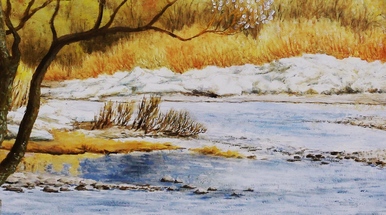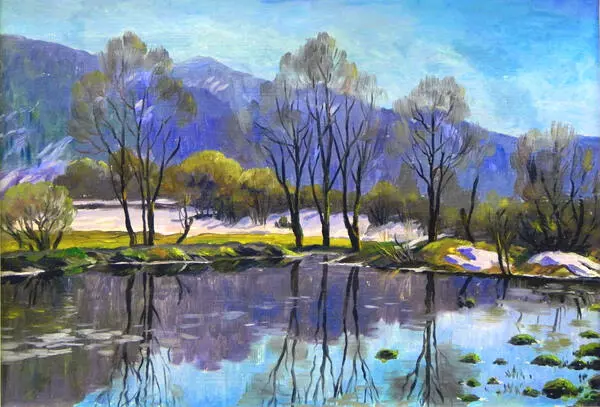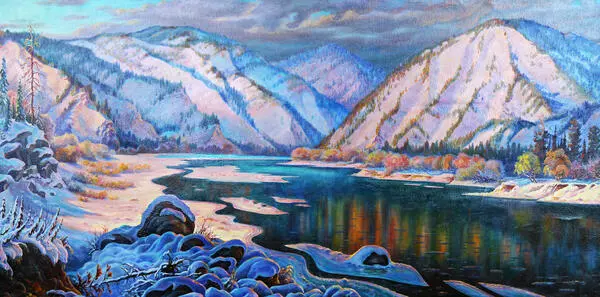Viktor Vasilievich Kharin is a talented artist with an interest in the history of his region — Koksa, and the gold mines in the Kuznetsk region and Altai territory. He has spent many years studying the history of his region, and has put together a fine collection of industrial, domestic and ethnographical artefacts. In his own house he has established a regional museum, where he is happy to welcome visitors. His art is well known and much loved in the Kuzbass region
He paints historical genre scenes, as well as lyrical depictions of Siberia’s landscapes and villages. He also enjoys painting the Mountain Shoria region, in all its striking beauty. His radiant landscape paintings awaken feelings of spirituality and joy, as well as a deep-seated melancholy in viewers. No-one who appreciates figurative art or the wistful beauty of the Siberian landscape is left unaffected by his paintings.
In A Frosty Day the artist depicts a mountain village in the winter. In the center of the painting we see a log cabin, part of a small village nestled among the high mountains. In the foreground a wooden fence is half covered by deep snow drifts. Inside the courtyard we see the outstretched branches of an elegant Russian birch tree. And on the left, we can glimpse the roof of a log cottage, and, behind it, the dark slopes of the mountains. The bright blue sky serves as a backdrop to the scene. All around lies brilliant white snow, and the street is drenched in sunlight. The artist has depicted the play of light and shade superbly. This work encapsulates the atmosphere of a bright frosty day.
The village depicted in this painting is Teba, in the Mezhdurechensk urban district of Kemerovo region. It is on the bank of the River Tom, and is surrounded by the forests of Mountain Shoria. Behind the village rises a dark mountain with a rather enigmatic name: Shaman. On that mountain can be found the site of the gold mine which the Russian emperor Alexander III gave to Grand Duke Nikolai Nikolaevich the Elder in 1886. The mine was later rented to Veniamin Astashev. In 1924 the village of Teba was granted the status of a settlement. At that time it had just five houses.
Between 1948 and 1958, on the left bank of the Tom, there was a labor camp here — the inmates were chiefly engaged in felling trees and loading the timber onto barges. At the end of the 1950s the construction of residential accommodation for forestry workers began here. The settlement became a processing center for the Kuznetsk forestry industry. It had a population of two thousand people. A school, workers, club, bakery, station and kindergarten were constructed. In the 1990s many of the buildings were classed as not longer fit for use, and the residents moved to the city. The settlement currently has thirteen streets. Its main attraction is Viktor Kharin’s house-museum.
He paints historical genre scenes, as well as lyrical depictions of Siberia’s landscapes and villages. He also enjoys painting the Mountain Shoria region, in all its striking beauty. His radiant landscape paintings awaken feelings of spirituality and joy, as well as a deep-seated melancholy in viewers. No-one who appreciates figurative art or the wistful beauty of the Siberian landscape is left unaffected by his paintings.
In A Frosty Day the artist depicts a mountain village in the winter. In the center of the painting we see a log cabin, part of a small village nestled among the high mountains. In the foreground a wooden fence is half covered by deep snow drifts. Inside the courtyard we see the outstretched branches of an elegant Russian birch tree. And on the left, we can glimpse the roof of a log cottage, and, behind it, the dark slopes of the mountains. The bright blue sky serves as a backdrop to the scene. All around lies brilliant white snow, and the street is drenched in sunlight. The artist has depicted the play of light and shade superbly. This work encapsulates the atmosphere of a bright frosty day.
The village depicted in this painting is Teba, in the Mezhdurechensk urban district of Kemerovo region. It is on the bank of the River Tom, and is surrounded by the forests of Mountain Shoria. Behind the village rises a dark mountain with a rather enigmatic name: Shaman. On that mountain can be found the site of the gold mine which the Russian emperor Alexander III gave to Grand Duke Nikolai Nikolaevich the Elder in 1886. The mine was later rented to Veniamin Astashev. In 1924 the village of Teba was granted the status of a settlement. At that time it had just five houses.
Between 1948 and 1958, on the left bank of the Tom, there was a labor camp here — the inmates were chiefly engaged in felling trees and loading the timber onto barges. At the end of the 1950s the construction of residential accommodation for forestry workers began here. The settlement became a processing center for the Kuznetsk forestry industry. It had a population of two thousand people. A school, workers, club, bakery, station and kindergarten were constructed. In the 1990s many of the buildings were classed as not longer fit for use, and the residents moved to the city. The settlement currently has thirteen streets. Its main attraction is Viktor Kharin’s house-museum.





